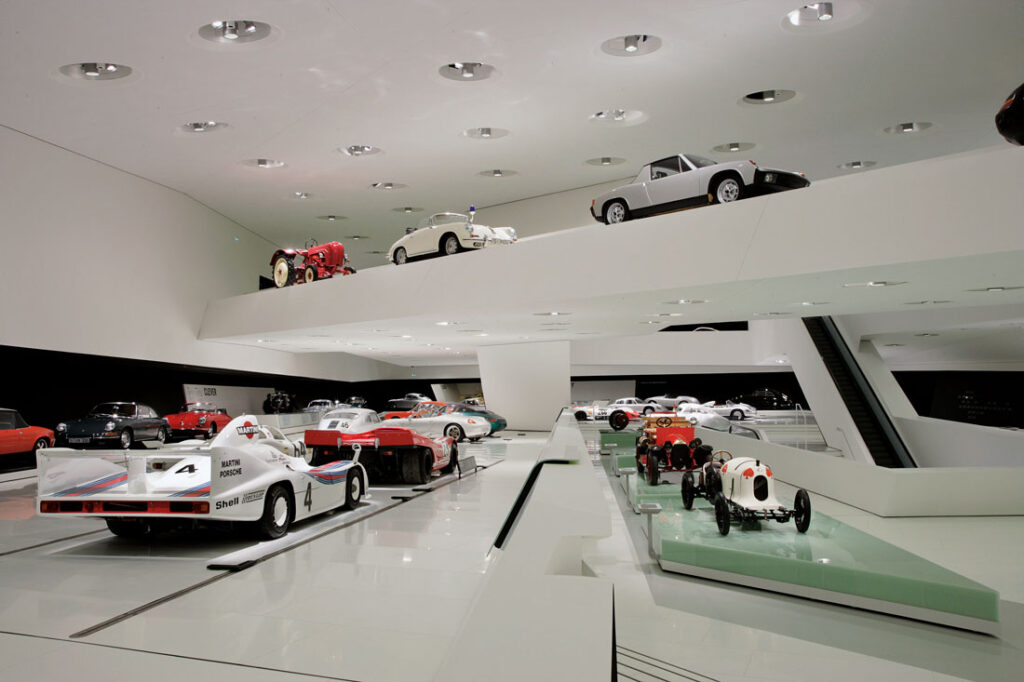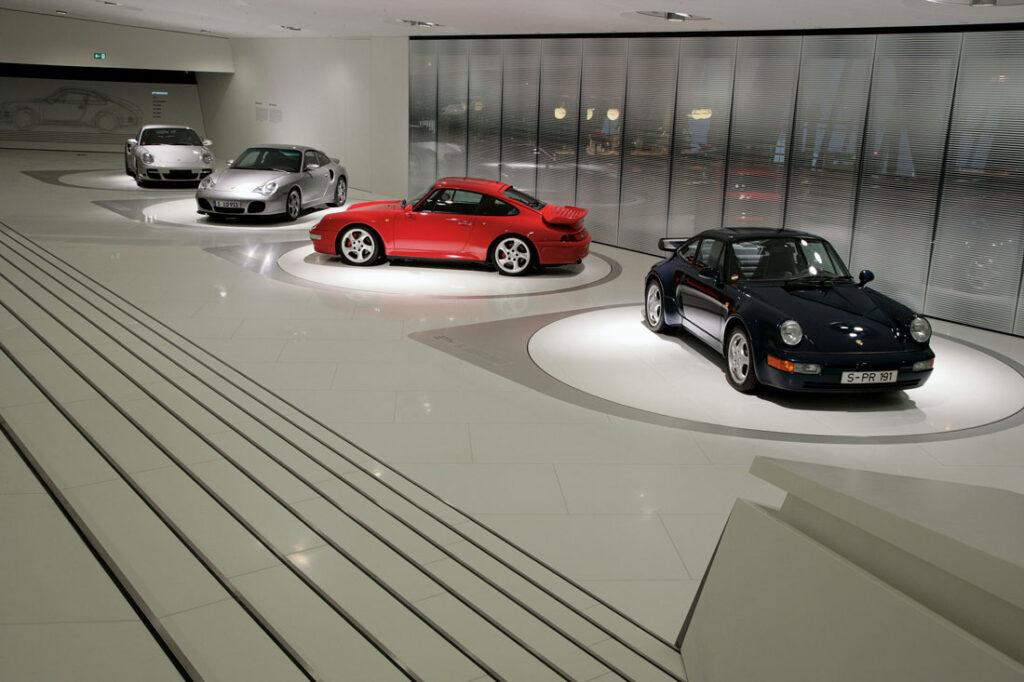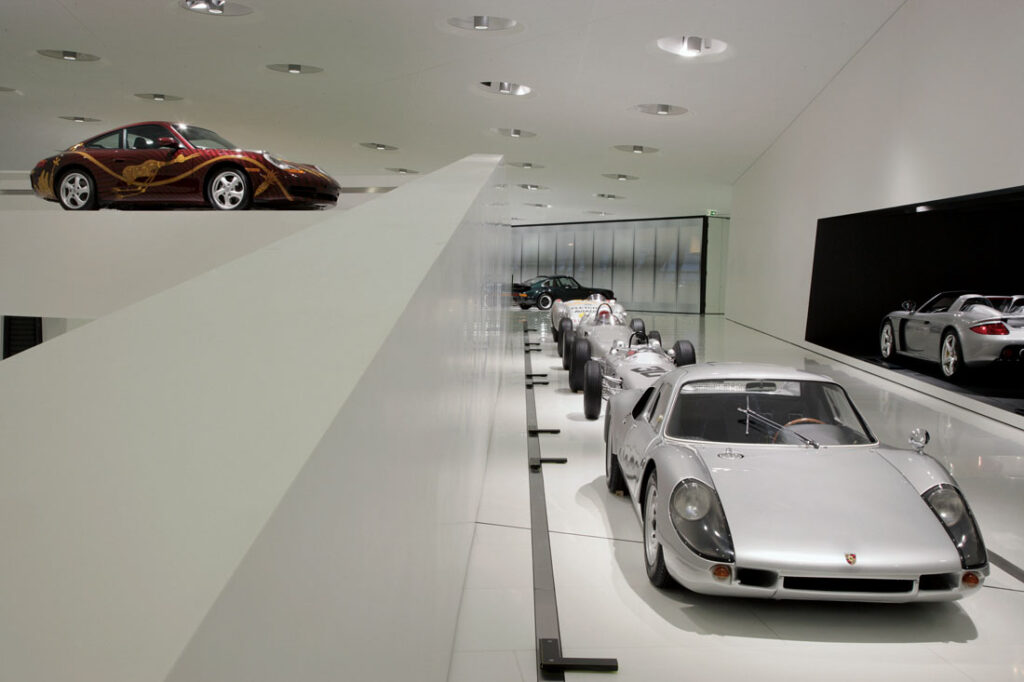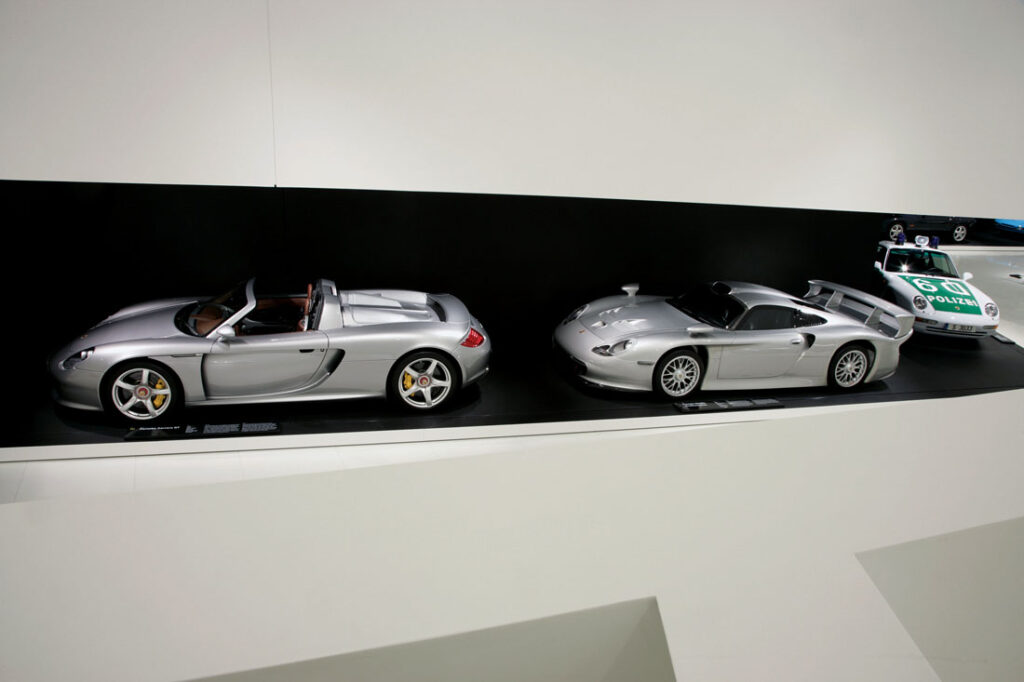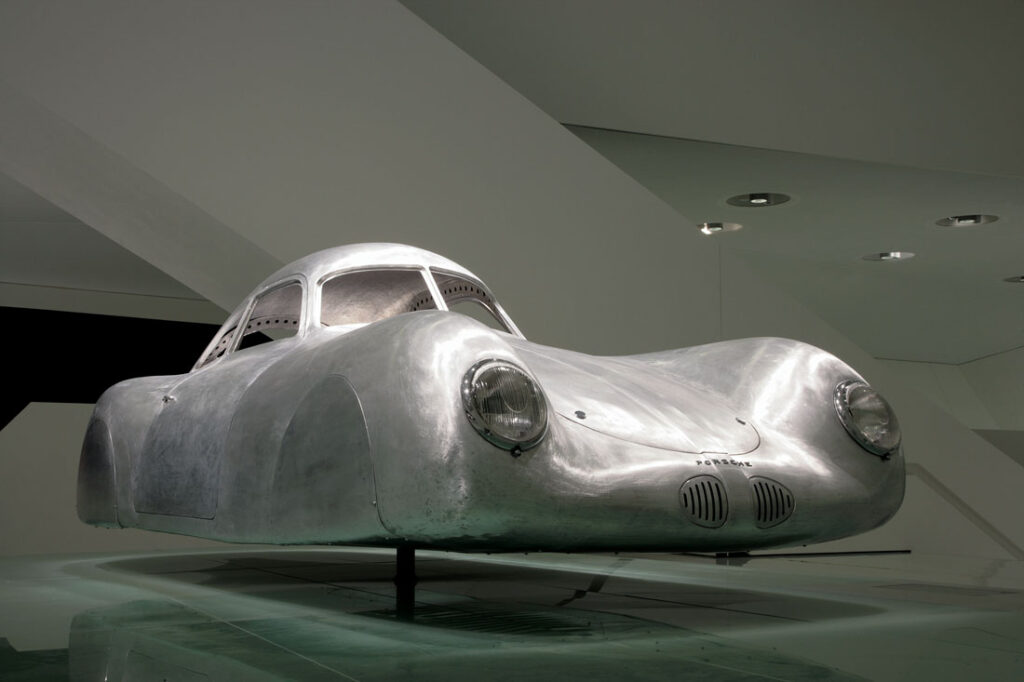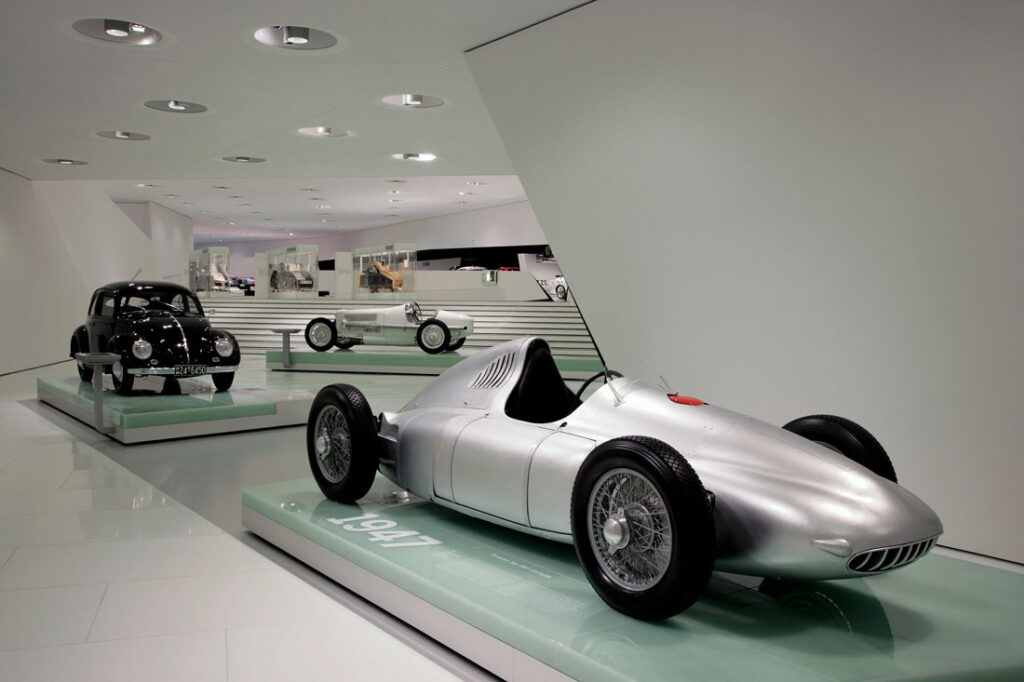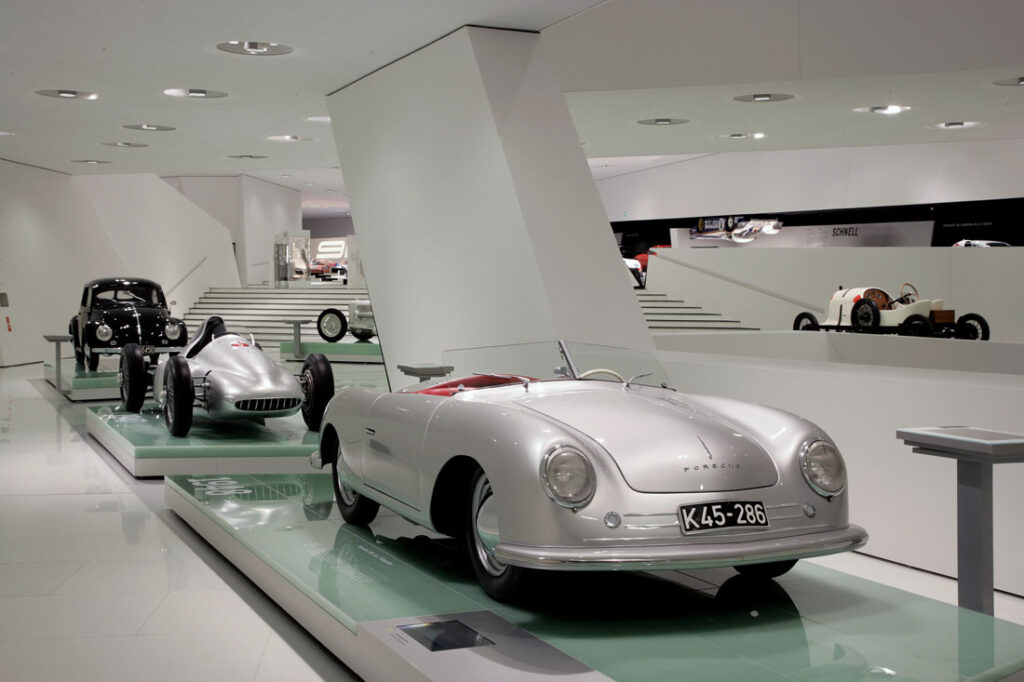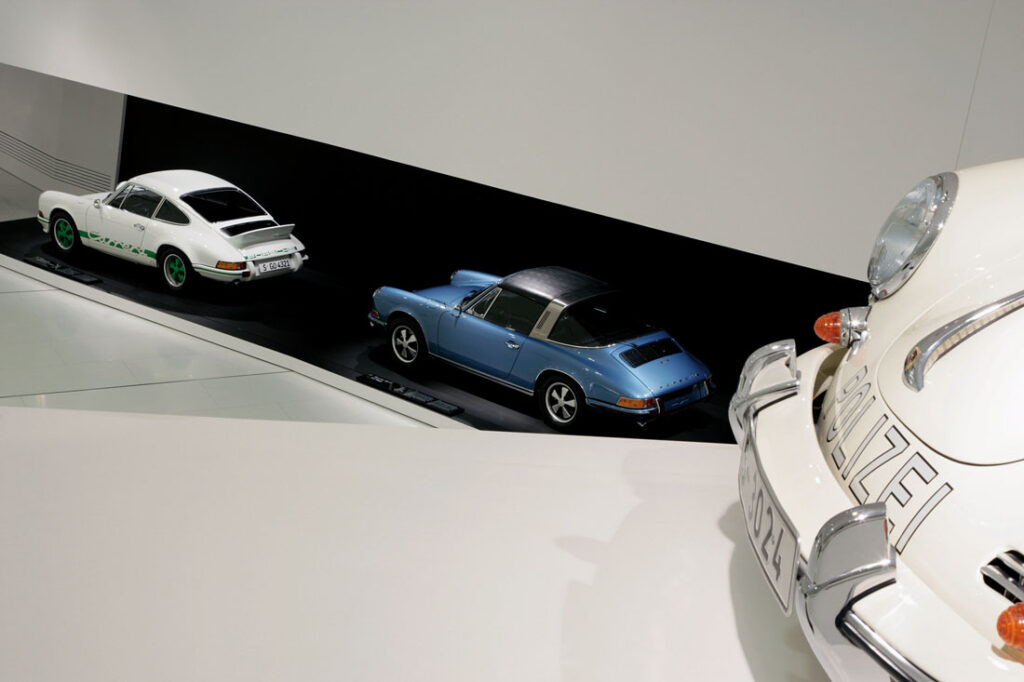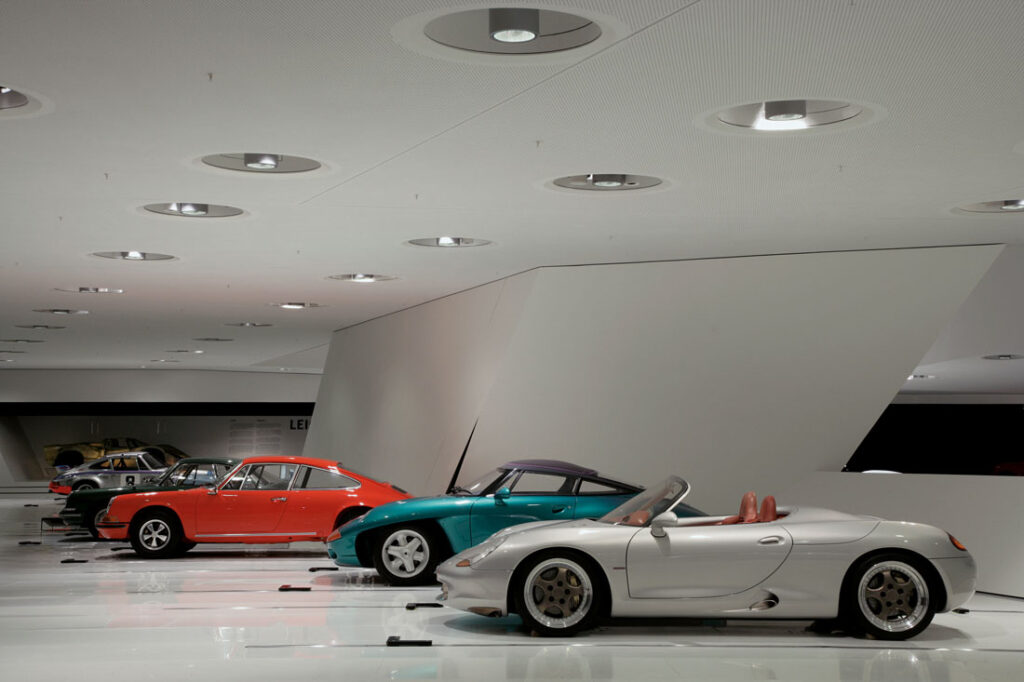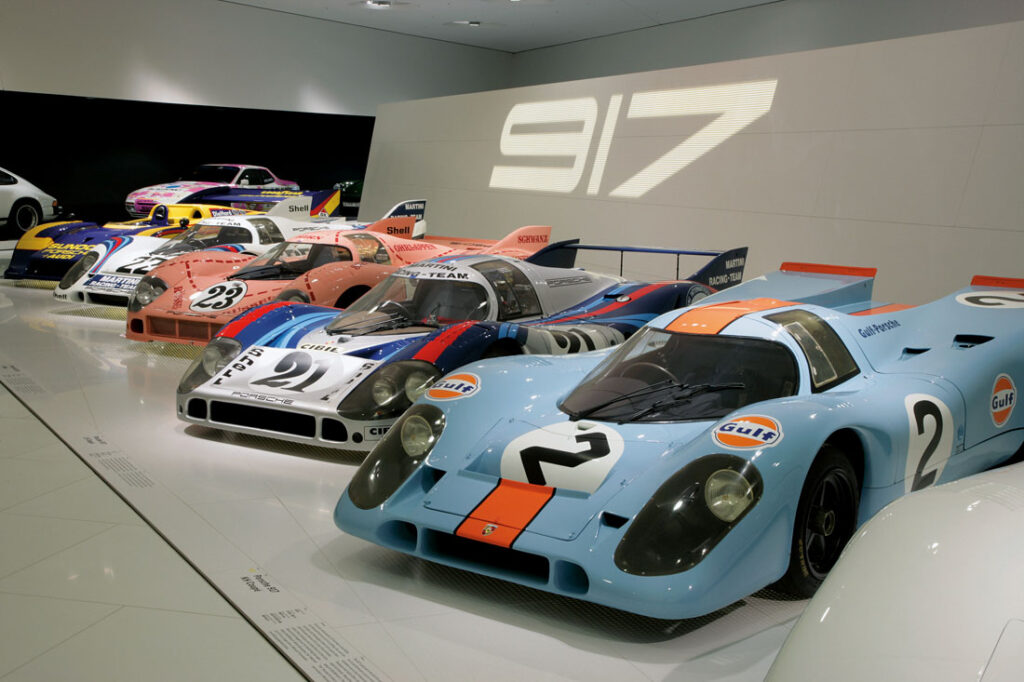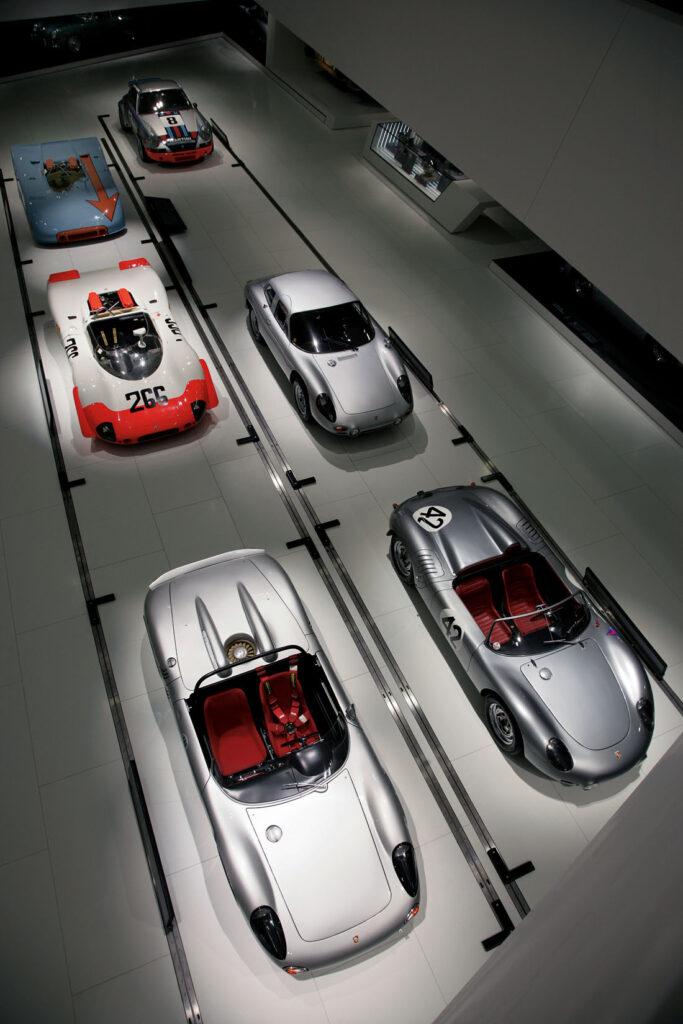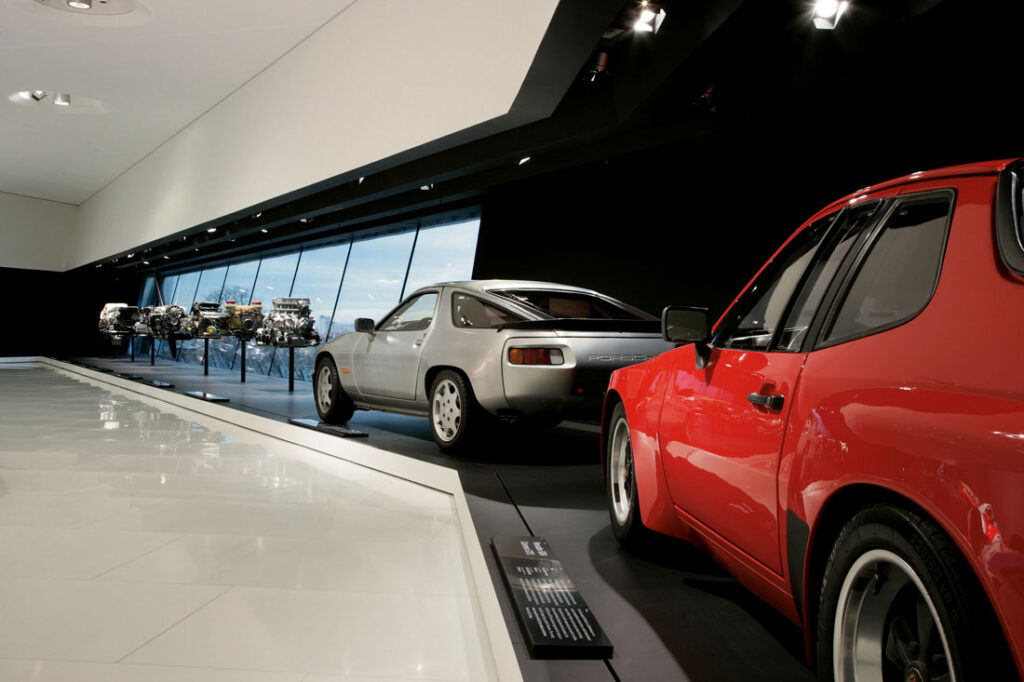One of the greatest and most spectacular building projects in the history of Dr. Ing. h.c. F. Porsche AG was completed in December 2008: the new Porsche Museum in Stuttgart-Zuffen – hausen. Located directly in the very heart of this unique sports car company so rich in tradition, the Museum serves to present the fascinating thrill and diversity of the Porsche brand to visitors from all over the world.
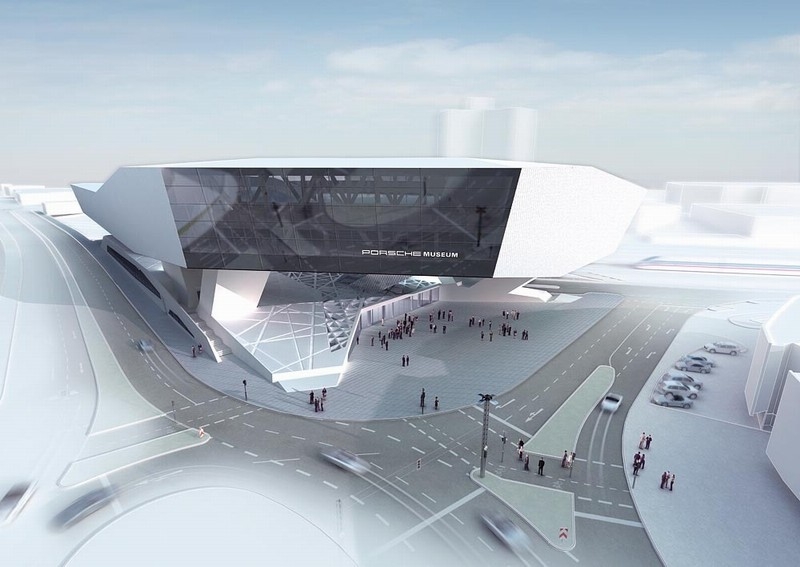
More than 80 cars are on display in the 5,600 square metre (60,250 square feet) Exhibition Area styled and designed futuristically by the Viennese architects Delugan Meissl, ranging from the legendary wheel hub motor of the Lohner-Porsche, the world’s first hybrid automobile built as far back as in 1900, all the way to the latest generation of the Porsche 911.
No less than 170 architects from all over Europe applied for the project before the architects of the Delugan Meissl office won the tender in February 2005. Construction work at Porsche – platz in Zuffenhausen started just half a year later and in November 2007 the body of the Exhibition Building was lowered on to three concrete cores, the first exhibits moving into the Exhibition Area not even one year later. On 8 December 2008, finally, the Museum was han – ded over to Porsche exactly on time.
Porsche expects more than 200,000 visitors to the Museum each year, so-called Theme Islands and numerous small exhibits seeking to present the “Porsche Idea” in all its complexity. Apart from the exhibition itself, the historical archives and the “transparent” workshop for historical cars, the Museum offers a wide range of catering services complete with a coffee bar, a bistro and an exclusive restaurant, as well as generous conference areas finished mainly in white, the fundamental colour of the Museum.
The new Porsche Museum is also available as an event location for other purposes, for example for conferences, film screenings or concerts, quite independently of the usual ex – hibition activities.
The new building at Porscheplatz is located at a very important place in the history of Ger – man automobile production, since this is where the Porsche Design Office moved to from downtown Stuttgart to Plant 1 in Zuffenhausen back in 1938. In the same year the forerunners of the VW Beetle saw the light of day precisely here at this location, followed by the Type 64 Porsche as the ancestor of all Porsche sports cars, the legendary Berlin-Rome car, in 1939.
Sports cars proudly bearing the now world-famous Porsche logo have been built here in Zuffenhausen ever since 1950.

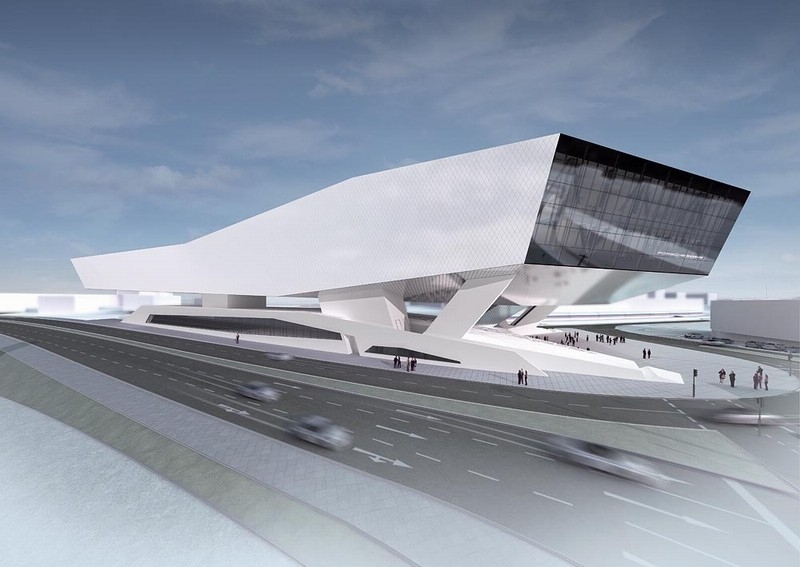
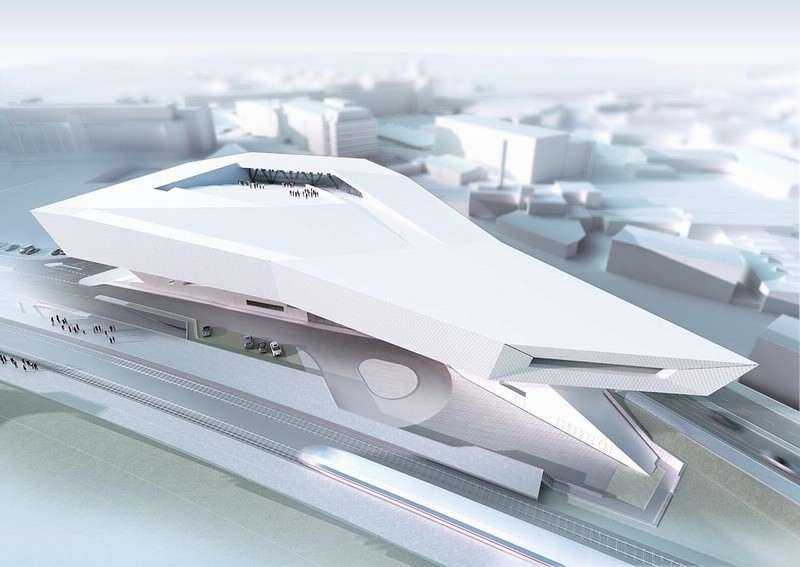
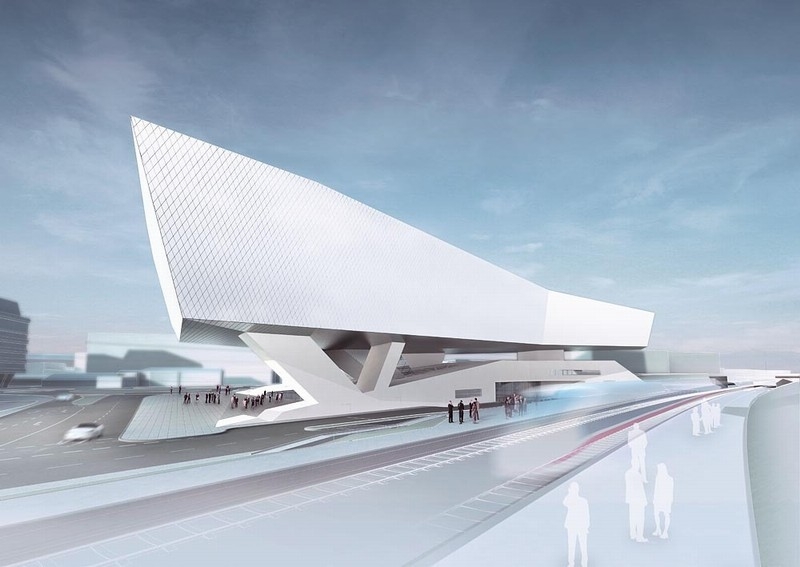
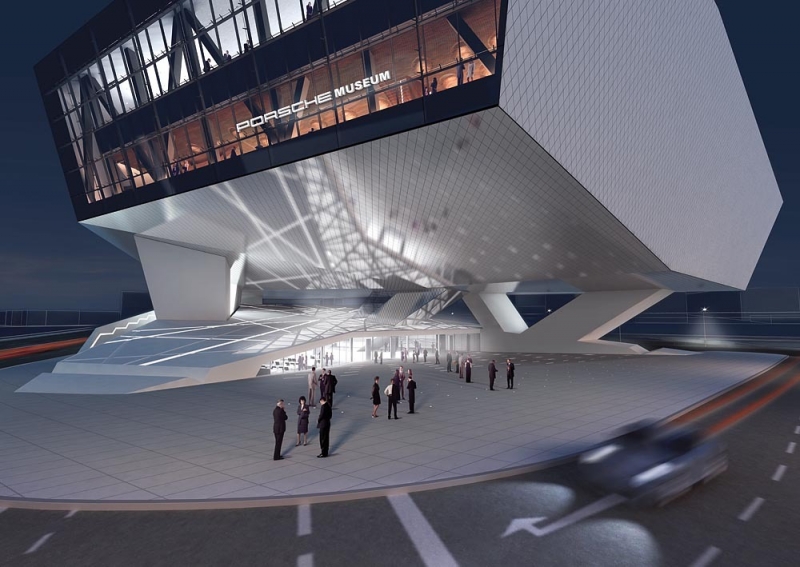
THE CONSTRUCTION.
Construction of the new museum of Dr. Ing. h.c. F. Porsche AG, Stuttgart, is running at full speed. “This is the most spectacular construction project in our Company’s history,” said Anton Hunger, head of Press and Public Relations at the sports car manufacturer, and also responsible for the museum project.
The shells of both basements and the first floor have now been completed. Work on the second floor and the three supporting concrete cores, which will bear the dynamically designed, apparently floating exhibition body, is progressing rapidly. A total of around 21,000 cubic centimeters of concrete and 4,000 tons of concrete reinforcement have already been laid.
“The new museum will be the business card at our headquarters in Stuttgart-Zuffenhausen and will represent the Company both inwardly and outwardly,” commented Hunger, emphasizing the importance of the project for the sports car manufacturer. The entire historical and contemporary knowledge of Porsche will be gathered in one location, on floor space of around 21,000 square meters. Hunger anticipates that the building will be completed in the second half of 2008.
Parallel to the work on the construction site, the exhibition design and the preparation of the exhibits is also proceeding apace. Christina Becker, project manager of the new museum, commented: “The exhibition will be dedicated to the era of Professor Ferdinand Porsche and his development work in the period between 1900 and 1948, all gathered in one place. Connected to this, as the main theme of the exhibition, is the product chronology of the Porsche sports car, which will be supplemented by more in-depth topic areas that are of particular significance for the Company’s history and philosophy.”
At the same time, the sports car manufacturer will adhere to the proven design of the “rolling museum.” “We will regularly exchange the 80 vehicles in the new museum with other racing and sports cars from our pool,” announced Klaus Bischof, director of the Porsche museum. Most of the exhibits will also be displayed at external events and driven in the future. “The patina of our racing and sports cars thus acquired should be deliberately visible in the museum,” said Bischof, “to inspire the visitor with their authenticity.” Numerous models, which will be on show in the new museum for the first time, are currently being prepared or restored, such as the Porsche 909 Bergspyder, a technology pioneer in light construction, which is now once again in a drivable condition for the first time since 1968.
A historical workshop is being constructed in the new museum for this work, which will give visitors an insight into the restoration of the exclusive sports car. In future, this workshop will not only feature the restoration and servicing of own exhibits, but will also focus on customers’ historical Porsche vehicles. In addition, the Company archive will be housed in the new museum. In addition to a restaurant and coffee bar in the foyer, there will be a conference area on the top floor as well as an exclusive restaurant, which will be opened independently of the museum operation and may also be leased by external interested parties.
Originally, 170 architectural offices from all over Europe applied to build the new museum at Porsche-Platz. The sports car manufacturer invited ten of these offices to compete, from which Viennese architects Delugan Meissl emerged as the winner in February 2005. Once Stuttgart state capital issued the building approval for the ambitious project just a few months later, construction work was begun in October 2005.
The Most Significant Museum Exhibits.
Type 64 (re-built).
Year of production: 1939 Power unit: four-cylinder boxer engine
Capacity: 1131 cc
Output: 33 bhp (24 kW)
Top speed: 140 km/h (87 mph)
It was beautiful, dynamic and fast – and it quickly became Ferdinand Porsche’s great passion: Although this unique sports car built for the Berlin-Rome long-distance race bore nothing but the simple model designation “Type 64”, it is acknowledged as the “original Porsche”, the “great-grandfather” of all Porsches to follow. Within and beneath its streamlined aluminium body, Type 64 boasts the trendsetting concepts so characteristic of all Porsche sports cars following in the years to come. In terms of design and aerodynamics this unique Coupé was far ahead of its time, the symbiosis of motorsport qualities and production features creating an ideal grand touring car. On public roads Type 64 reached a top speed of no less than 130 km/h or 81 mph. Ferdinand Porsche often drove this car himself, showing his deep satis – faction by presenting the Porsche family name on the car itself.
VW Beetle.
Year of production: 1950
Power unit: four-cylinder boxer engine
Capacity: 1131 cc
Output: 25 bhp (18 kW)
Top speed: 105 km/h (65 mph)
When Ferdinand Porsche presented his “Study for the Construction of a German People’s Car” in January 1934, this was the eighth small car built under his guidance. Creating this compact model, Porsche and the engineers at his Construction Office offered highlights such as an air-cooled four-cylinder engine mounted at the rear, a crank arm axle, torsion bar suspension, and the subdivision of the car’s structure into a floorplate and the body itself. Through its design, the Beetle combined superior streamlining with sufficient space for four persons, in the process creating the famous Beetle silhouette. Total production of the Beetle by Volks – wagen AG up to the year 2003 amounted to 21.5 million units worldwide.
Porsche 356 “No. 1” Roadster.
Year of production: 1948
Power unit: four-cylinder boxer engine
Capacity: 1131 cc
Output: 35 bhp (26 kW)
Top speed: 135 km/h (84 mph)
The first sports car to bear the name Porsche was built in spring 1948 in the small Austrian town of Gmünd (Province of Carinthia). Creating this unique vehicle, Ferry Porsche for the first time lived out his idea of a truly modern sports car. The prototype Porsche Type 356 “No. 1” was ready to go on 8 June and the Carinthian State Government issued a special per – mit for testing on public roads. This mid-engined sports car was powered by a VW engine increased in its output to 35 bhp. Weighing 585 kg or 1,290 lb, the Porsche 356 “No. 1” achieved a top speed of 135 km/h (84 mph). In August 1948 the car clearly proved its spor – ting qualities in the Innsbruck City Race.
Porsche 356 Coupé “Ferdinand”.
Year of production: 1950
Power unit: four-cylinder boxer engine
Capacity: 1086 cc
Output: 40 bhp (29 kW)
Top speed: 140 km/h (87 mph)
A new chapter in the history of Porsche started on the Thursday before Easter 1950 when
the first Type 356 built in Stuttgart came out of the production hall. With all test cars by
tradition receiving a name at Porsche, the model on display in the new Museum was called
“Ferdinand” and was a gift for Ferdinand Porsche on his 75th birthday on 3 September 1950.
The car was subsequently used as a “rolling test vehicle”.
Porsche 356 America Roadster.
Year of production: 1953
Power unit: four-cylinder-boxer engine
Capacity: 1488 cc
Output: 70 bhp (51 kW)
Top speed: 177 km/h (110 mph)
A special roadster built exclusively for the North American market and significantly lighter than the other models in the 356 series produced at the same time. The car reached its ideal weight of 605 kg or 1,334 lb through its extra-light aluminium body with low door cutouts, stick-on side windows and an emergency roof. This truly spartan fore – runner to the 356 Speedster was conceived specifically for motorsport.
Porsche 550 A Spyder.
Year of production: 1956
Power unit: four-cylinder boxer engine
Capacity: 1498 cc
Output: 135 bhp (99 kW)
Top speed: 240 km/h (149 mph)
“Little Bastard” was the name that legendary US film star James Dean gave his Porsche 550 intentionally built with all the aggressive attributes required for motorsport. Just 24 years old, Dean died in his private Spyder in 1955 on his way to the race track in Salinas, California, when another driver took his right of way.
Type 754 “T7”.
Year of production: 1959
Power unit: four-cylinder boxer engine
Capacity: 1966 cc
Output: 130 bhp (96 kW)
Top speed: 200 km/h (124 mph)
Ferdinand Alexander Porsche’s T7 styling study was a milestone on the way to the final design of the 911. Since Ferry Porsche refused to build a regular four-seater, “T7” never entered standard production. But Ferry Porsche did have the car re-built as a 2+2-seater, jump seats at the rear maintaining the typical look of a fastback coupé.
356 B 2000 GS Carrera GT.
Year of production: 1960
Power unit: four-cylinder boxer engine
Capacity: 1966 cc
Output: 175 bhp (129 kW)
Top speed: 220 km/h (136 mph)
The Porsche 356 not only came with a new face, but also with innovative technology. The moving body parts made of aluminium are indeed a good example of such innovations. Other trendsetting features are the safety steering with hydraulic dampers and the optimised brake cooling system. The availability of various transmission ratios was likewise new. The additio – nal name “Carrera” was borne as of 1955 on all models with a racing engine.
Porsche 911 2.0 Coupé.
Year of production: 1964
Power unit: six-cylinder boxer engine
Capacity: 1991 cc
Output: 130 bhp (96 kW)
Top speed: 210 km/h (130 mph)
In 1963 Porsche proudly presented the successor to the 356 at the Frankfurt Motor Show: the original 911. The 911 differed in many respects from its predecessor, not only through its fast-revving six-cylinder power unit. And Ferry Porsche was happy “to be able at last to fit his golf set into the car without a problem.” Originally code-named the 901, the model designation had to be changed into the magical numbers 911, since Peugeot claimed the right to all three-digit numbers with a zero in the middle.
Porsche 914/8.
Year of production: 1969
Power unit: eight-cylinder boxer engine
Capacity: 2997 cc
Output: 300 bhp (221 kW)
Top speed: 250 km/h (155 mph)
In the late ‘60s the close connection between Porsche and Volkswagen, which had grown consistently in the course of time, led to the construction of the VW-Porsche 914 – a dyna – mic but economical sports car. Apart from the four-cylinder VW version, there was a sixcylinder version of this very agile mid-engined sports car built exclusively for Porsche. And there were two cars with an eight-cylinder power unit carried over from motorsport, one of which was given to Ferry Porsche as a gift for his 60th birthday.
Porsche 911 S 2.2 Targa.
Year of production: 1970
Power unit: six-cylinder boxer engine
Capacity: 2195 cc
Output: 180 bhp (132 kW)
Top speed: 230 km/h (143 mph)
In response to new, strict legislation in the USA, Porsche built the first production safety convertible in the world to meet this challenge: In the mid-60s Porsche’s engineers created a special version of the 911 positioned in between the Cabriolet and the Coupé, inventing the Targa principle. This Targa version with its stable, removable roof quickly won over the hearts of a very special group of customers. Even the most powerful S-model (S for Sport) was available with the typical rollbar.
Porsche 908/03 Spyder.
Year of production: 1970
Power unit: eight-cylinder boxer engine
Capacity: 2997 cc
Output: 350 bhp (257 kW)
Top speed: 275 km/h (171 mph)
Weighing just 545 kg or 1,202 lb, the Spyder was an extreme rendition of lightweight techno – logy, the body made of reinforced-foam plastic weighing just 12 kilos or 26.5 lb. To ensure even better weight distribution, the driver and the power unit were moved to the front. The 908/3 Spyder to be admired here was raced only four times by the Works Team and won three races in the process, including its first race in the 1970 Targa Florio on Sicily with Jo Siffert and Brian Redman at the wheel.
Porsche 917 Short-Tail Coupé.
Year of production: 1971
Power unit: twelve-cylinder boxer engine
Capacity: 4907 cc
Output: 600 bhp (441 kW)
Top speed: 360 km/h (223 mph)
In 1971 Gijs van Lennep and Helmut Marko set up a track record destined to go down in history. Averaging 222.30 km/h or 137.83 mph, they covered a distance of 5,335.16 kilo – metres (3,315.31 miles) in the 24 Hours of Le Mans. Once again Porsche’s engineers had gone for nothing but the best in terms of streamlining and low weight. The short-rear ver sion of the 917 comes with shark fins on both sides of the rear hood, the frame is made of extra-light magnesium.
Porsche 917/30 Spyder.
Year of production: 1973
Power unit: twelve-cylinder boxer engine, turbocharged
Capacity: 5374 cc
Output: 1200 bhp (882 kW)
Top speed: 385 km/h (239 mph)
It is referred to as the “most powerful racing car of all times” – the upgraded twelve-cylinder power unit which dominated race tracks all around the world. With Mark Donohue at the wheel a Porsche brought home superior victory in the CanAm Series also the second time around, way ahead of McLaren. For the first time the turbocharged power unit also showed its merits on a winding track.
Porsche 911 Carrera RS 2.7 Coupé.
Year of production: 1973
Power unit: six-cylinder boxer engine
Capacity: 2687 cc
Output: 210 bhp (154 kW)
Top speed: 240 km/h (149 mph)
The fastest German production car of its time was characterised by its unique rear spoiler referred to in popular terms as the “ducktail”. Introducing all kinds of aerodynamic improve – ments, Porsche set an important trend through this particular model, this spartan coupé living out the concept of “more power through more displacement and less weight” without the slightest compromise. The RS 2.7 was the first 911 to bear the name “Carrera” derived from the classic Carrera Panamericana road race.
Porsche 924.
Year of production: 1974
Power unit: four-cylinder inline
Capacity: 1984 cc
Output: 125 bhp (92 kW)
Top speed: 200 km/h (124 mph)
Responding to the energy crisis in the mid-70s, VW decided to cancel a joint sports car pro – ject planned with Porsche. As a result Porsche created the 924 as its own entry-level model leading into the range. Right from the start, the first model was characterised by its large glass tailgate as a striking design feature. The 924 with its water-cooled front-mounted en – gine and transaxle configuration entered production at the Audi Plant in Neckarsulm in 1974.
Porsche 911 Turbo 3.0 Coupé.
Year of production: 1976
Power unit: six-cylinder boxer engine, turbocharged
Capacity: 2994 cc
Output: 260 bhp (191 kW)
Top speed: 250 km/h (155 mph)
Porsche’s first production car to use an exhaust gas turbocharger for extra power developed an almost incredible 260 bhp at the time. And indeed, the 911 Turbo was a bold move in the days of the energy crisis. The 911 Turbo immediately took over the top position within Porsche’s model range, benefiting from technology proven in motorsport. Apart from the turbocharged power unit, this technology was to be admired above all on the brakes and the car’s streamlining.
Porsche 928 S.
Year of production: 1983
Power unit: V8
Capacity: 4664 cc
Output: 300 bhp (221 kW)
Top speed: 250 km/h (155 mph)
The 928 was originally intended as the successor to the 911, but quickly emancipated into a unique model in its own right. In 1978, just one year after being launched into the market, the 928 became the first sports car in history to be elected as the “Car of the Year”. In technical terms the concept differed fundamentally from the 911 through its transaxle trans – mission, the water-cooled V8 light-alloy power unit, and the aluminium suspension.
McLaren TAG MP 4/2 C Formula 1.
Year of production: 1986
Power unit: V6, turbocharged
Capacity: 1499 cc
Output: 850 bhp (625 kW)
Top speed: approx 350 km/h (217 mph)
Developing new models of the highest calibre for external customers: Working in behalf of the TAG Group, Porsche built an engine destined to revolutionise Formula 1. This high-per – formance power unit displacing just 1 ½ litres developed enormous power in the McLaren Formula racing car, setting the foundation for three World Championship titles scored by Alain Prost and Niki Lauda as well as 25 Grand Prix wins between 1983 and 1987.
Porsche 959.
Year of production: 1988
Power unit: six-cylinder boxer engine with register turbocharger
Capacity: 2849 cc
Output: 450 bhp (331 kW)
Top speed: 315 km/h (195 mph)
No other Porsche offers the same passionate symbiosis of competition and high technology as the 959. Originally conceived for the new Group B racing category, the 959 was built in an exclusive series of just 292 units as a spearhead in technology based on the 911 model series. Subsequent production models benefited significantly from this supersports car with its attractive looks. Despite its price tag of DM 420,000, the 959 was quickly sold out.
Panamericana Concept Car.
Year of production: 1989
Power unit: six-cylinder boxer engine
Capacity: 3557 cc
Output: 250 bhp (184 kW)
Top speed: 210 km/h (130 mph)
On his 80th birthday Ferry Porsche received a roadgoing concept car based on the 911 Carrera 4.
Bearing the name “Panamericana”, this unique model built in the course of only a few months was also presented at the 1989 Frankfurt Motor Show. The concept with its horizontal roof structure had a strong influence on the ongoing development of the 911 Targa and also paved the way for the construction of a new roadster, the Porsche Boxster soon to follow.
Porsche Boxster.
Year of production: 1996
Power unit: six-cylinder boxer engine
Capacity: 2480 cc
Output: 204 bhp (150 kW)
Top speed: 240 km/h (149 mph)
This two-seater roadster with its mid-mounted engine continued Porsche’s Spyder tradition, using modern technology in the process. Following an overwhelming response to the initial Boxster Show Car, the Company decided to build the production model. For technical rea – sons the roadgoing Boxster differed from the concept version but was nevertheless fully accepted as a thoroughbred Porsche. And while anticipating some features of the later gene – ration of the 911, the Boxster always remained a unique model in its own right.
Porsche Carrera GT.
Year of production: 2003
Power unit: V10
Capacity: 5733 cc
Output: 612 bhp (450 kW)
Top speed: 330 km/h (205 mph)
The driving experience is both undiluted and mind-boggling: Through its design language alone, the Carrera GT clearly stands out as an uncompromising top-level performer. Boasting all the values of a modern racing car – supreme performance, extreme lightweight engineering, superior safety – the Carrera GT was originally conceived for racing in Le Mans and was then built in an exclusive series of just 1,270 units in Leipzig, standing out forever as an ultra-low mid-engined supersports with a unique carbon-fiber body.
General Information.
Address.
Porsche Museum
Porscheplatz
D – 70435 Stuttgart
Germany
Museum and Exhibition opening hours.
Tuesdays – Sundays 9:00 am – 6:00 pm.
The admission counters close at 5:00 pm.
Closed on Mondays.
Christophorus Restaurant opening hours.
Tuesdays – Saturdays 11:30 am – 12:00 pm.
Sundays 11:30 am – 2:30 pm.
There is separate access to the Restaurant.
Museum Workshop opening hours.
Mondays – Fridays 9:00 am – 4:00 pm.
Outside of official opening hours on request.
Admission prices.
Adults: 8 Euro
School-children, students, apprentices, members drafted to the Armed Forces and civil services, senior citizens, disabled, unemployed: 4 Euro
Underground car park.
Capacity: 260 vehicles
Parking fee: 2 Euro (flat rate)
General Visitor Enquiries.
Tel: 01805 356 911
e-Mail: [email protected]

